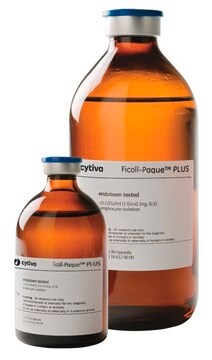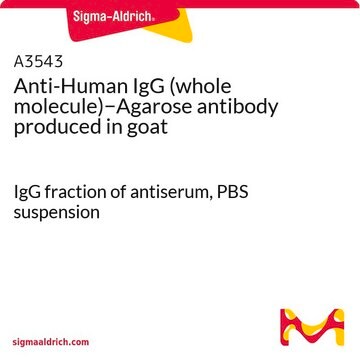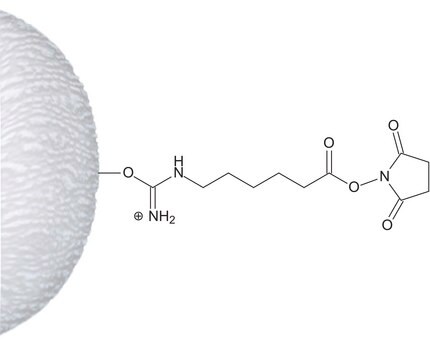A3316
Anti-Human IgG (Fc Specific)−Agarose antibody produced in goat
affinity isolated antibody, PBS suspension
Sinonimo/i:
Goat anti-human IgG
About This Item
Prodotti consigliati
Origine biologica
goat
Coniugato
agarose conjugate
Forma dell’anticorpo
affinity isolated antibody
Tipo di anticorpo
secondary antibodies
Clone
polyclonal
Forma fisica
PBS suspension
Reattività contro le specie
human
Non deve reagire con
rat, mouse
tecniche
Ouchterlony double diffusion: suitable
Capacità
2 mg/mL, resin binding capacity (human IgG)
Temperatura di conservazione
2-8°C
modifica post-traduzionali bersaglio
unmodified
Descrizione generale
Goat Anti-Human IgG (Fc Specific)-Agarose antibody is specific for the Fc fragment of human IgG when tested against purified human IgA, IgG, IgM, Fc, and kappa and lambda light chains. No reactivity with mouse or rat IgG is seen by Ouchterlony Double Diffusion (ODD), prior to agarose bead coupling.
Immunogeno
Applicazioni
Altre note
Stato fisico
Esclusione di responsabilità
Non trovi il prodotto giusto?
Prova il nostro Motore di ricerca dei prodotti.
Codice della classe di stoccaggio
10 - Combustible liquids
Classe di pericolosità dell'acqua (WGK)
WGK 3
Certificati d'analisi (COA)
Cerca il Certificati d'analisi (COA) digitando il numero di lotto/batch corrispondente. I numeri di lotto o di batch sono stampati sull'etichetta dei prodotti dopo la parola ‘Lotto’ o ‘Batch’.
Possiedi già questo prodotto?
I documenti relativi ai prodotti acquistati recentemente sono disponibili nell’Archivio dei documenti.
I clienti hanno visto anche
Il team dei nostri ricercatori vanta grande esperienza in tutte le aree della ricerca quali Life Science, scienza dei materiali, sintesi chimica, cromatografia, discipline analitiche, ecc..
Contatta l'Assistenza Tecnica.












